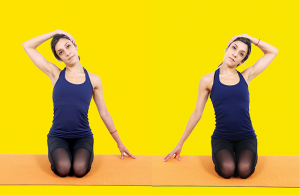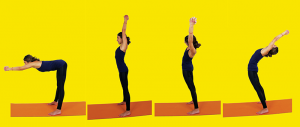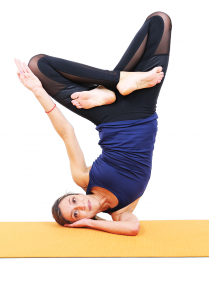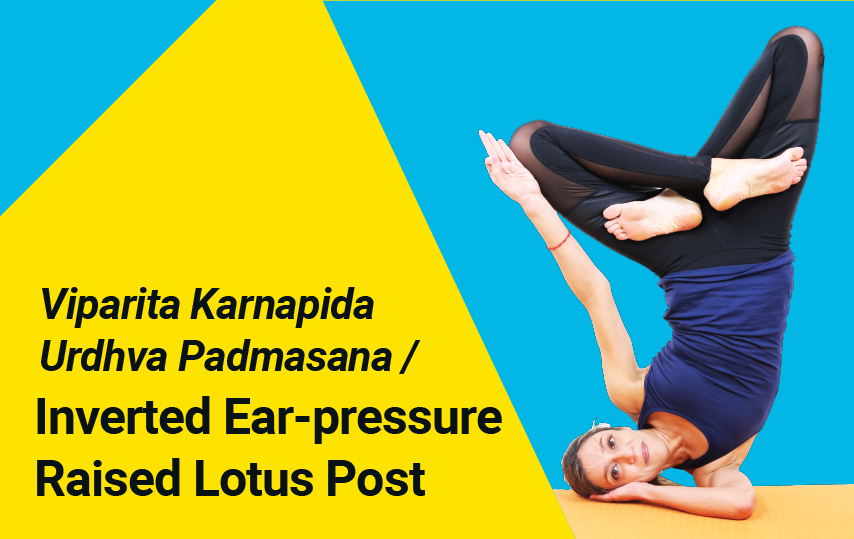This month’s featured pose is Viparita Karnapida Urdhva Padmasana or Inverted Ear Pressure Raised Lotus Post. The name of the pose is derived from the following terms:
viparita – inverted
Karna – ear
pida – pain or pressure
urdhva – up or upwards
padma – Lotus
asana – pose
This pose might seem challenging but with proper guidance and body coordination, this pose could be easily accessible to many practitioners.
Chakra Awareness
Vishuddhi Chakra / Throat
Practice Level
Intermediate
Degree of Difficulty
(100 being most difficult)
80
Movement
Lateral Flexion / Abduction of the neck and spine
Sideways movement away from the midline of the body – moving the spine to the left or right so that the thorax moves to the side toward the pelvis, or tilting the head sideways.
External Hip Rotation
A movement of turning the thigh or pelvis outward; also known as lateral rotation.
Hip extension
A movement of the hip joint muscles, where the hip insuflaveis joint straightens by being pushed forward (i.e. the thigh or top of the pelvis is brought backward).
Challenges faced during the practice
Balance
Lack of body coordination
Disorientation
Chances of Injury
Neck or spine injury
Contraindications
Existing upper body or hip issues
Low or High blood pressure
Due to the irregularity of the blood pressure, coming into an inversion may lead to increased oxygen in the brain; in most cases, the body can regulate the pressure but for some, this may result in nausea or dizziness.
Major Muscles Involved
Oblique Muscles
Composed of the external and internal oblique muscles, these work together to pull the lower wall of the chest cavity down, increasing the volume of the lungs which fills with air. It is also responsible for the flexion and rotation of the vertebral column, as in forward & backward bending, lateral and twisting movements.
Quadratus Lumborum
Located at the back of the abdominal wall, this muscle keeps the spine and pelvis movement stable
Erector Spinae
A muscle group found in the back that extends the vertebral column in forward and backward bending. This muscle is responsible for returning the vertebral column to the erect position after motion.
Splenius Capitis
Located at the back of the neck, connected to the base of the skull and vertebrae of the neck, this muscle is majorly involved in the extension of the head. It also allows lateral flexion and rotation of the cervical spine.
Sternocleidomastoid
Located at the anterior sides of the neck, this muscle functions to flex the neck and extend the head.
Iliopsoas
The combination of the iliac and psoas major muscles that make an important part of the hip flexors. Also known as the dorsal or inner thigh hip muscles, the iliopsoas work for the flexion of the hip.
Best Time to Practice
Morning, when the body is refreshed and energized.
………………….
Warm-up
The below warm-up focuses on the rotational and lateral movement of the neck and the torso. These practices prepare the specific muscles to come into Viparita Karnapida Urdhva Padmasana.
Neck Warm-up
- Sit on the heels and come into
 Vajrasana or diamond pose
Vajrasana or diamond pose - Bring the right hand to the left side of the head and extend the right arm, hand touching the floor. Inhale and on exhale, tilt the head to the right.
- Hold the stretch for two gentle breaths and release.
- Repeat the movement on the other side.
………………….
Mandalasana / rotational movement

In this warm-up practice, aim to keep the arms in line with the ears to keep the chest open and to avoid hunching the back.
- From Tadasana/Mountain pose, separate the legs brincolin wider than hip width and raise the arms above the head, interlocking the fingers.
- Inhale and on exhale, lean forward and bring the torso in line with the hips. Maintain legs straight; look towards the fingers or down to the floor.
- Inhale and on the next exhale, rotate the body to the left side, coming into Konasana/Angle pose.
- Inhale again and on exhale, push the hips forward and arch the back to go into a backward bend.
Return to upright position and repeat, going to the opposite side.
Final Pose
Bend the right knee and slide the foot close to the left side of the hip, then bend the left knee and bring the left shin on top of the right, crossing the legs to come into Padmasana or Lotus pose.
More…
To read the full article please download our Asana Journal App or purchase Issue 165 September 2016.



















 Other
Other